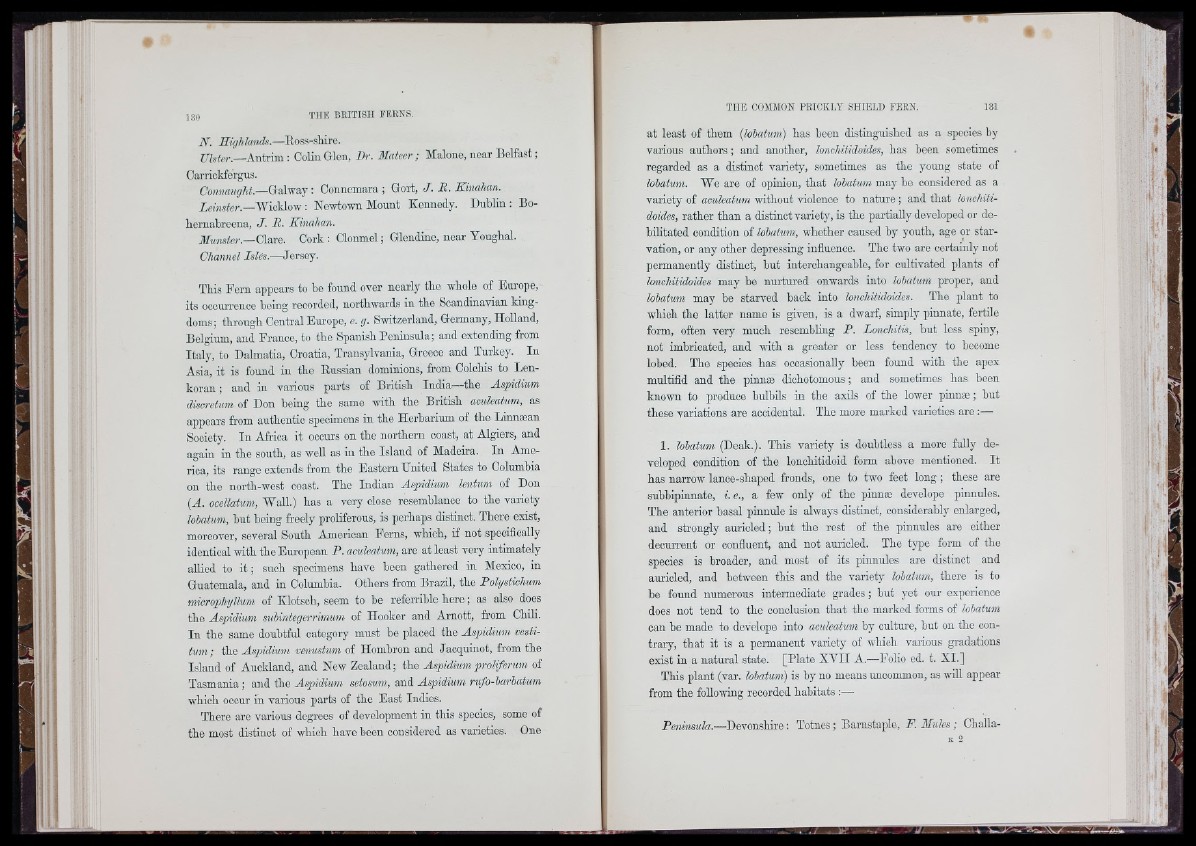
iV. Highlands.—Ross-shire.
Ulster.—An trim: Colin Glon, Dr. Mateer; Malone, near Belfast;
Carrickforgus.
Connaught.—Galway: Connemara; Cori, J . R . IGnahan.
Leinster.— SYiddov!: Newtown Mount Kennedy. Dublin : Bo-
hornabreena, J . R . Kinahan.
Munster.— Clara. Cork ; Clonmel; Glendinc, near Youghal.
Channel Isles.—Jersey.
This Fern appears to be found over nearly tho whole of Europe,
its occurrence boing recorded, northwards in tho Scandinavian kingdoms;
through Central Europe, o. g. Switzerland, Germany, IloUand,
Belgium, and France, to the Spanish Peninsula; and extending from
Italy, to Dalmatia, Croatia, Transylvania, Greece and Turkey. In
Asia, it is found in the Russian dominions, from Colchis to Lenkoran
; and in various parts of British India—the Aspidium
discretum of Don being tho samo with the British aculeatum, as
appears from authentic specimens in tho Herbarium of tho Linnaean
Society. Ill Africa it ooours on the northern coast, at Algiers, and
again in the south, as well as in the Island of Madeira. In America,
its range extends from the Eastern IJnitcd States to Columbia
on the north-west coast. The Indian Aspidium lentum of Don
{A. occllatum, Wall.) has a very close resemblance to the variety
lobatum, but being freely proliferous, is perhaps distmot. There exist,
moreover, several South American Ferns, which, if not specifically
identical with the European P . aculeatum, are at least very intimately
allied to i t ; such specimens have been gathered in Mexico, in
Guatemala, and in Oolumhia. Others from Brazil, tho P olystichum
microphyllum of Klotsoh, seem to be referrible h e re ; as also does
the Aspidium subintegerrimum of Hooker and Arnott, from Chili.
In the same doubtful category must he placed the Aspidium vesti-
tmn; the Aspidium venustum of Hombron and Jaoquinot, from the
Island of Auckland, and New Zealand; the Aspidium proliferum of
Tasmania ; and the Aspidium sctosum, and Aspidium rufo-barbatum
which occur in various parts of the East Indies.
There are various degrees of development in this species, some of
the most distinct of which have been considered as varieties. One
at least of them {lohatum) has boon distinguished as a species by
various authors ; and another, lonoMtidoides, has boon sometimes
regarded as a distinct variety, sometimes as the young state of
lobatum. We are of opinion, that lobatum may be considered as a
variety of aculeatum without violence to nature ; and that lonoliiti-
doides, rather than a distinct variety, is tho partially developed or debilitated
condition of lobatum, whether caused hy youth, ago or starvation,
or any other depressing influence. The two are certainly not
permanently distinct, but interchangeable, for cultivated plants of
lonchitidoides may be nurtured onwards into lobatum proper, and
lobatum may be starved back into lonchitidoides. The plant to
which the latter name is given, is a dwarf, simply pinnate, fertile
form, often very much resembling P . Lonchitis, hut loss spiny,
not imbricated, and v ith a greater or less tendency to become
lobed. The species has occasionally been found with the apex
multifid and the pinnæ dichotomous ; and sometimes has been
known to produce bulbils in the axils of tho lower pinnæ ; but
these variations are accidental. The moro marked varieties are :—
1. lohatum (Deak.). This variety is doubtless a more fully developed
conditiou of tho lonohitidoid form above mentioned. I t
has narrow lance-shaped fronds, one to two feet long ; these are
suhbipinnate, i.e., a few only of the pinnæ develope pinnules.
The anterior basal pinnule is always distinct, considerably enlarged,
and strongly auricled; but the rest of the pinnules are either
decurrent or confluent, and not amioled. The type form of the
species is broader, and most of its pinnules are distinct and
auricled, and between this and the variety lobatum, there is to
he found numerous intermediate grades ; but yet our experience
does not tend to the conclusion that the marked forms of lobatum
can be made to develope into aculeatum by culture, but on the contrary,
th a t it is a permanent variety of which various gradations
exist in a natural state. [Plate X V II A.—Folio ed. t. X I.]
This plant (var. lobatum) is by no means uncommon, as will appear
from the following recorded habitats ;—■
Peninsula.—Devonshire ; Totnes ; Barnstaple, P. Mules ; Challa-
K 3
'■I '
I n
■ I;
I :
I t |4,
( iki
-J.:'..